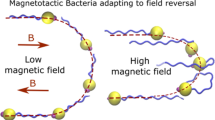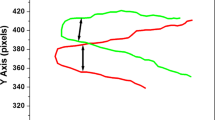Abstract
Motion of flagellate bacteria is considered from the point of view of rigid body mechanics. As a general case we consider a flagellate coccus magnetotactic bacterium swimming in a fluid in the presence of an external magnetic field. The proposed model generalizes previous approaches to the problem and allows one to access parameters of the motion that can be measured experimentally. The results suggest that the strong helical pattern observed in typical trajectories of magnetotactic bacteria can be a biological advantage complementary to magnetic orientation. In the particular case of zero magnetic interaction the model describes the motion of a non-magnetotactic coccus bacterium swimming in a fluid. Theoretical calculations based on experimental results are compared with the experimental track obtained by dark field optical microscopy.
Similar content being viewed by others
References
Arnold VI (1973) Ordinary Differential Equations. MIT Press, Cambridge
Berg HC (1975) Bacterial behaviour. Nature 254: 389–392
Berg HC (1983) Random Walk in Biology. Princeton University Press, Princeton, NJ
Blakemore RP (1975) Magnetotactic bacteria. Science 190: 377
Crenshaw HC (1993 a) Orientation by helical motion — I. Kinematics of the helical motion of organisms with up to six degrees of freedom. Bull Math Biol 55: (1) 197–212
Crenshaw HC (1993 b) Orientation by the helical motion — III: Microorganisms can orient to stimuli by changing the direction of their rotational velocity. Bull Math Biol 55: (1) 231–255
Crenshaw HC, Edelstein-Keshet L (1993) Orientation by helical motion — II. Changing the direction of the axis of motion. Bull Math Biol 55: (1) 213–230
Esquivel DMS, Lins de Barros HGP (1986) Motion of magnetotactic microorganisms. J Exp Biol 121: 153–163
Farina M, Esquivel DMS, Lins de Barros HGP (1990) Magnetic iron-sulphur crystals from magnetotactic microorganism. Nature 343: 256–258
Frankel RB (1984) Magnetic guidance of organisms. Annu Rev Biophys Bioeng 13: 85–103
Frankel RB, Blakemore RP, Torres de Araujo FF, Esquivel DMS, Danon J (1981) Magnetotactic bacteria at geomagnetic equator. Science 212: 1269–1270
Goldstein H (1980) Classical Mechanics, 2nd edn. Addison-Wesley, Reading, Mass
Kalmijn AJ (1981) Biophysics of geomagnetic field detection. IEEE Trans. Mag 17: (1) 1113–1124
Lamb H (1932) Hydrodynamics. Dover, New York
Lins de Barros HGP, Esquivel DMS (1985) Magnetotactic microorganisms found in muds from Rio de Janeiro. A general view. In: Biomineralization and Magnetoreception in Organisms. Kirschvink JL, Jones DS, Macfadden BJ (eds) Plenum Press, New York
Lins de Barros HGP, Esquivel DMS, Farina M (1990) Magnetotaxis. Sci Prog Oxford 74: 347–359
Lins de Barros HGP, Esquivel DMS, Farina M (1991) Biomineralization of a new material by a magnetotactic microorganism. In: Iron Biominerals. Frankel RB, Blakemore RP (eds) Plenum Press, New York
Lovalenti PM, Brady JF (1993) The hydrodynamic force on a rigid particle undergoing arbitrary time-dependent motion at small Reynolds number. J Fluid Mech 265: 561–605
Mann S, Sparks NHC, Frankel RB, Bazylinski DA, Janasch HW (1990) Biomineralization of ferrimagnetic greigite (Fe3S4) and iron pyrite (FeS2) in a magnetotactic bacterium. Nature 343: 258–261
Manson MD, Tedesco P, Berg HC, Harold FM, van der Drift C (1977) A protonmotive force drives bacterial flagella. Proc Natl Acad Sci, USA 74: (7) 3060–3064
Purcell EM (1977) Life at low Reynolds number. Am J Phys 45: (1) 3–11
Schreiner KE (1971) The helix as propeller of microorganisms. J Biomech 4: 73–83
Author information
Authors and Affiliations
Additional information
Correspondence to: H. G. P. Lins de Barros
Rights and permissions
About this article
Cite this article
Nogueiral, F.S., de Barros, H.G.P.L. Study of the motion of magnetotactic bacteria. Eur Biophys J 24, 13–21 (1995). https://doi.org/10.1007/BF00216826
Received:
Accepted:
Issue Date:
DOI: https://doi.org/10.1007/BF00216826




